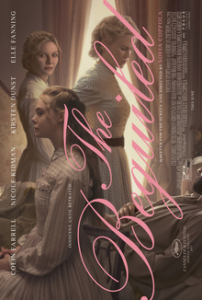film review: the beguiled

Sofia Coppola’s latest film, The Beguiled, opens with what seems like an innocent scene: a young girl out in the woods, humming to herself as she collects wild mushrooms. Yet there is something else going on beneath the surface: an undeniably sinister undertone present despite beautiful imagery.
To beguile means to ‘persuade, attract, or interest someone, sometimes in order to deceive them’. The film’s title might be a reference to its characters and plot, but it could also describe the viewing experience itself, where attractive imagery obscures the disturbing plot twists to come.
The film is set at a girls’ school in Virginia during the American Civil War. Only those students who have nowhere else to go are still attending. Run by the strict but kind Miss Martha (Nicole Kidman) and her understudy Miss Edwina (Kirsten Dunst), the school is going about its business despite what is happening in the outside world. That is until one of the girls, Miss Amy (Oona Laurence), stumbles upon a wounded Union soldier named Corporal McBurney (Colin Farrell) in the nearby forest.
Despite Miss Martha’s reluctance, the women collectively decide it would be the Christian thing to do to take Corporal McBurney in and allow him to heal before turning him over to the Confederate Army. At first, the solider is a welcome addition to the household, and the women each vie for his affections. Things take an ugly turn when one of these flirtations becomes physical, and Miss Martha and her charges must then decide how to rid themselves of McBurney for good.
Without a doubt, the best aspect of this film is its visuals. As with previous Coppola films like Marie Antoinette, aesthetics are just as important (if not more) than dialogue and plotline. In The Beguiled, Civil War era gowns and delicate interiors create a soft, typically ‘feminine’ aesthetic, making Corporal McBurney seem particularly out of place. Outside, the gentle green of the forest clashes with the black smoke of war in the distance, creating a simmering tension that builds as the film goes on. The atmosphere is captivating: distant gunfire is a constant companion, an unavoidable reminder to the inhabitants of the school that while they focus on the politics and romance of their small world, a war goes on around them.
The camera captures many small moments and makes them big: the forest floor is shown in detail as Miss Amy collects mushrooms, light shines through a window with an almost tragic beauty, and the camera rests on Colin Farrell’s bare chest as Nicole Kidman washes her patient, suggesting so much about the tension between the two characters and what might be going on inside Miss Martha’s head, without even showing us her face.
This film is relatively unique in that its lead cast is made up of seven women and one man. When Corporal McBurney first arrives, the girls and their teachers are besotted with him, which is of course a fairly stereotypical gender power dynamic. The women fawn and fight over him, and jealousy is particularly present between the two adult women (not that they speak openly of their feelings; everything is conveyed with a look). Miss Martha and her charges also collectively nurture McBurney as they nurse him back to health, again creating the predictable relationship of women providing maternal care to a man.
However, the balance of power shifts suddenly after McBurney is discovered in bed with one of the school girls. Miss Martha and her pupils band together against the man who has become a threat to them, and now their collective strength is used for their own protection rather than his comfort. At last, the women are given a kind of power they can use.
Coppola herself is in a unique position of power as a female director and screenwriter of the film, something still far too uncommon. She won the Best Director award at Cannes 2017 for The Beguiled, and she was only the second woman to ever take out the title, making this film significant for the progression of women in the industry.
Yet there is one major part of The Beguiled that sits uneasily for many: its ‘whitewashing’ of this historical period. After all, the story is set during a war that was fought in no small part over slavery. Yet there is just one mention of slavery in the entire film (Miss Amy tells Corporal McBurney when she finds him that ‘the slaves left’) and not one African American character appears in the film. As Steve Rose notes in The Guardian, Coppola’s adaptation removes both non-white characters that were present in the book and original film adaptation. This has created a lot of controversy around the film. Coppola herself told BuzzFeed News that she ‘didn’t want to brush over such an important topic in a light way’. ‘Young girls watch my films and this was not the depiction of an African-American character I would want to show them,’ she said. For an in-depth analysis of the politics of Coppola’s choices, check out Ira Madison III’s piece for The Daily Beast.
The Beguiled is beautiful to watch, despite the disturbing nature of the plot. But for some, the whitewashing of this historical period may overshadow the film entirely.

